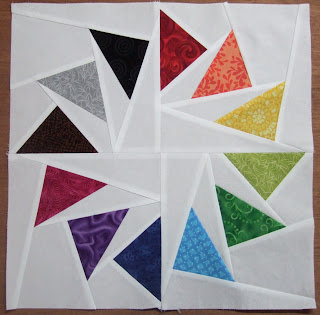If you've never blocked a quilt before, it really isn't difficult. It just takes a little time. By the way, I blocked this quilt before sewing binding to it. Machine baste along the edges of the quilt sandwich to hold it all together during washing.
Oh, and I also need to say that every fabric in this quilt has already been washed. I've been a pre-washer since the early 80s. I know that every fabric in my stash has been washed, and I'm going to keep it that way.
 First, fill the washing machine with cold water. In this case I didn't use any detergent, but if you feel the need to do so, I recommend Quilt Soap. Carefully add the quilt, gently "feeding" it into the machine. On the delicate cycle, let it agitate, occasionally checking under the lid to make sure the quilt isn't getting twisted, and is staying submerged. Then, let the washing machine do it's thing to spin the load, though I didn't let it run the entire spin cycle. Gently, remove the quilt from the washing machine and put it in a laundry basket to carry it to where it can be laid out to dry.
First, fill the washing machine with cold water. In this case I didn't use any detergent, but if you feel the need to do so, I recommend Quilt Soap. Carefully add the quilt, gently "feeding" it into the machine. On the delicate cycle, let it agitate, occasionally checking under the lid to make sure the quilt isn't getting twisted, and is staying submerged. Then, let the washing machine do it's thing to spin the load, though I didn't let it run the entire spin cycle. Gently, remove the quilt from the washing machine and put it in a laundry basket to carry it to where it can be laid out to dry.Normally, on a nice day where rain isn't imminent (lately, it's rained nearly every day here in Central Iowa), I'll block the quilt on our back deck, laying one flat bed sheet on the deck, and another flat bed sheet on top of the spread-out quilt, to protect it while it dries. For this large quilt, I moved aside living room furniture, vacuumed (we have a dog), and then laid a large flat sheet on the carpeting. That's where I spread out the quilt.
Trying not to tug on it, I used the palm of my hand to spread out the wet quilt. Since this is a medallion style quilt, I had many reference points - borders - to check that every part was laying on the straight.
I set up a small oscillating fan to dry it. I'm sure it will take a couple days to dry thoroughly with our high humidity and no air-conditioning running.
If you noticed batting showing on the edges, you're correct that I haven't bound the quilt yet. My thoughts are that if you block after you've sewn binding to a quilt, you may also find yourself trying to square a quilt and binding that isn't sewn on straight.
When it's completely dry, I'll proceed to binding. I have in mind to try a couple new things, based on Sharon Schamber's binding video here. Linda






















































